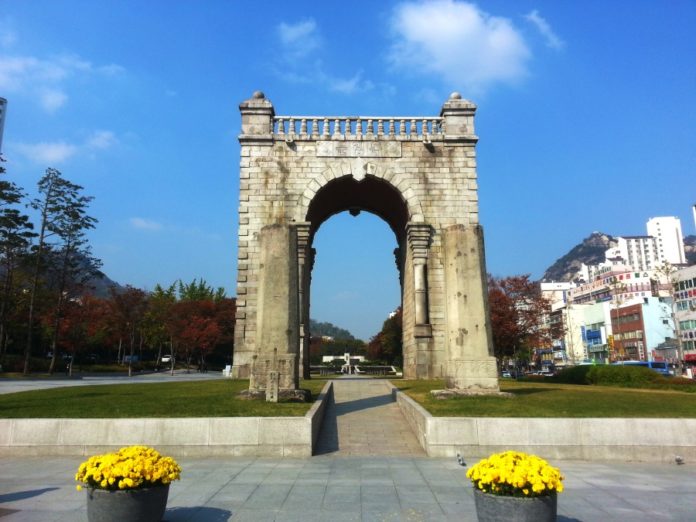(Media1=William Harlow) Seoul is an interesting city with a long history. Hundreds of years ago, during the early days of the Joseon (Chosun) Dynasty, the capital use to be up north near Kaesong. Early on in the dynasty, for political, economic, and defensive reasons, the decision was made to move it to another location (shown in the historical television drama Joeng do Joeng). In the early Joseon era it was called Hanyang. Know we know it as Seoul. Today Seoul’s expanse is on both sides of the Han River (Hangang, gang being river in Korean). Gangnam (literally river south) is the glittery upscale fashionable part of the city. Fifty years ago this area was just small villages and rice paddies.
The original city was build north of Namsan (South Mountain). It was a walled city with four main gates at the cardinal points of the compass (North or Buk; South or Nam; East or Dong; and West or Seo). The city also had four smaller gates at the intermediate directions of the compass. In Korea, a gate is called a mun. The word for great or big is dae. Therefore, the primary gates would be called Bukdaemun (North Big Gate), Namdaemun (South Big Gate), Dongdaemun (East Big Gate), and Seodaemun (West Big Gate). Seoul has other gates as well; however, they are not necessarily part of the main wall and served other purposes’ in the city. A famous example is Ganghwamun at the south end of Kyongbokkung Palace. (Note: The gates have other names as well, but we don’t have time to go into that here.)
Seoul’s walls have been restored and it is quite a walk to go around them. Three of the four main gates have also been restored as have three of the smaller gates. Namdaemun recently was destroyed by fire (2008), but has now been restored back to its former glory (work completed in 2013). Namdaemun is National Treasure Number 1. Both Namdaemun and Dongdaemun are also famous because of the large markets located nearby. Bukdaemun has also been restored and is a well-known shopping district as well. The only main gate that has not is the Seodaemun; however, its location gives its name to the area. (Seosomun or West Small Gate is the only small gate not rebuilt). This is a historically interesting day trip that does not involve shopping next time you have a few hours to kill in Seoul. Seodaemun is easy to get to by subway. You just take Line 3 (the orange line) to the Tongnimmun stop and you are there.
Using this exit in the subway station will take you in the direction of the Seodaemun Tongnip (Independence) Park (Exit number 4 or 5). The park has a visitor center and numerous statues and monuments. However, in my view, the park has two key historical sights. The first is the Tongnimmun (Independence Arch or Gate) and the second is the Seodaemun Prison (West Gate Prison). It is these two sites that we will focus on here.
Tongnimmun (also spelled Dongnimmun depending on your Romanization system) was built in about a year between November 1896 and November 1897. It was modeled after the Arc de Triomphe in Paris, France. It is made of granite. The arch was built shortly after end of the Sino-Japanese War of 1894-1895. The result of this conflict gave Japan the island of Formosa (Taiwan) and other territorial concessions in China. It also forced China to relinquish its claim of Korea (Joseon) as a vassal state. This war set the stage for Japanese incursions into Manchuria and other parts of China as well as the eventual colonization of Korea in 1910. The arch was built to replace a previous arch (Yeongeunmun) that represented Joseon’s previous political relationship with China. (The pillars from this old arch can be seen in front of the new one). Funds were raised by a citizens group called the Independence Club. It was meant to represent a fully independent Korea (Joseon) that was the hope at the time.

I remember driving by the Tongnimmun in the early 1970s. It was located in the middle of the road and was very hard to gain access to. In the ever growing Seoul, new highway construction forced the government to move the gate in 1979. It is now locate in Seodaemun Independence Park and you can now walk under it and get a good view. While you are looking at it, please note the positioning of the ying and yang symbol on the flag engraved in the gate and the different orientation to the one on the current flag.
The next area of interest in the part is the Seodaemun Prison. Build in 1907; it was used by the Japanese to imprison Korean resistance leaders and political prisoners. It is now a museum that you can tour. You can see the cells and the interrogation rooms. There are displays that give you a good deal of information on the Japanese occupation of Korea and the brave resistance of the Korean people to this occupation. Like most prisons, it is not a happy place; however, it is important to give you a historical perspective of Korean history in the first half of the 20thCentury.

Once you are done touring the park you can spend a little time in the area around the park. There are a few coffee shops, hofs, and restaurants. I stopped by one for some beer and chicken. Most of the places were nice, but not significantly different from those you find elsewhere in Seoul. Seodaemun Independence Park is a great way to spend and afternoon. It is easy to get to and a place many people visiting Seoul don’t even know is there. It is well worth a visit.
Photo by: Jungchan Lee and Cultural Heritage Administration










